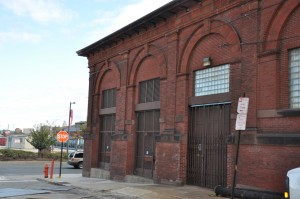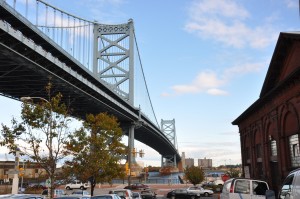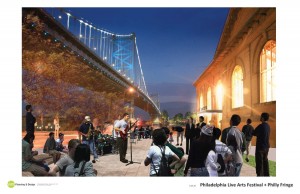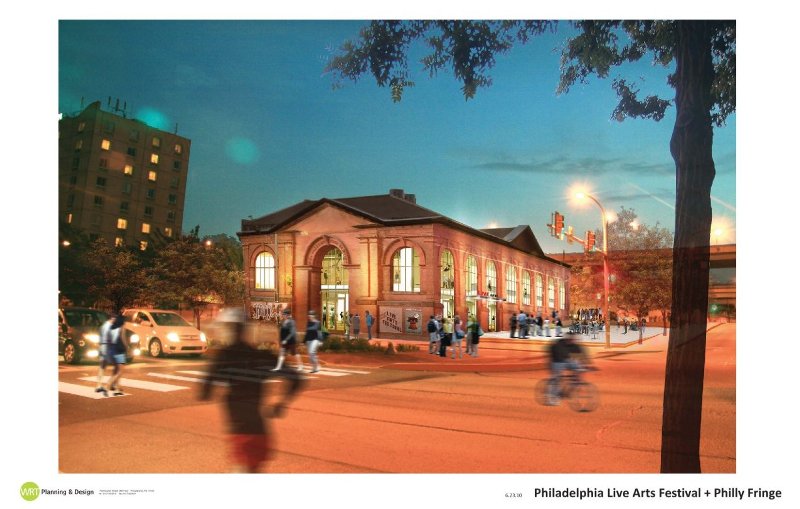
Home of the future Live Arts headquarters in the historic High Pressure Fire Service Building (Photo credit: Philadelphia Live Arts Festival and Philly Fringe)
The historic High Pressure Fire Service Building on the corner of Race Street and Columbus Boulevard will have a new life as the permanent headquarters of the Philadelphia Live Arts Festival. The brick-and-terracotta pump house, built in 1903, is soon to be converted into a year-round performing and visual arts center, with a 250-seat theater, bar-restaurant, DJ booth, box office, rehearsal studios, and administrative offices. Its adjacent outdoor space, with a beautiful (albeit noisy) view of the Ben Franklin Bridge and the Delaware River, is slotted to become an open-air plaza fitted with seating, an awning, and a stage, offering seasonal live music and entertainment.

The new Live Arts headquarters site at the corner of Race Street and Columbus Boulevard (Photo credit: Philadelphia Live Arts Festival and Philly Fringe)
In advance of this year’s Live Arts and Fringe Festival, co-founder and producing director Nick Stuccio led a walking tour of the building and discussed the selection of the site. Purchased from the City for under $1 million with a grant from the state’s Redevelopment Assistance Capital Program, the 10,000-square-foot Victorian structure is well located near the developing riverside frontier in Old City, the neighborhood where the Philadelphia Fringe had its origins; it is large enough to contain the proposed multiple functions; and, because it is zoned beyond the I-95 highway overpass, it is eligible for a liquor license.

Rendering of the new design for the Live Arts building and outdoor plaza (Photo credit: WRT Planning & Design)
Live Arts enlisted the services of two impressive firms for the building’s renovation. Antonio Fiol-Silva of Wallace Roberts & Todd is the principal architect on the project, and Richard Stokes (most recently of Stephen Starr’s Frankford Hall fame) is responsible for the restaurant. According to Stuccio, the new design will incorporate some of the water station’s original fittings as part of the interior décor, including a map of the system, overhead hoists, large water tanks, and the updated electrical pumps installed in 1954. It will also restore the missing corbels on the building’s exterior, and remove the old glass bricks from the windows, opening up the 25-foot-high arches to views of the surrounding area.
The timetable for the construction, after securing the final $400,000 of the $4.5 million project, will be approximately seven to eight months, with the opening tentatively scheduled for the spring of 2013, in plenty of time for next September’s Philadelphia Live Arts Festival and Philly Fringe. Along with the grant from RACP, funding has been received from the William Penn, Lenfest, and Independence Foundations, ArtPlace, members of the Festival’s Board of Directors, and donations. The new Live Arts headquarters is not only a major coup for the arts in Philadelphia, but also for the city’s historic preservation, waterfront redevelopment, and social scene. By my count, that’s a win/win/win/win situation!
PHILADELPHIA LIVE ARTS FESTIVAL AND PHILLY FRINGE
Future headquarters
140 North Columbus Boulevard
Philadelphia, PA 19106
http://www.livearts-fringe.org



1 comment
Kudos for the arts scene in Philadelphia however,if the average household spends there time and money on cable television and reality programming.Its a tough sell also conciddering the recent closings of some retail galleries that cannot sustain themselves because of the lack of original art purchases.Plus, the theatre arts scene suffers due to the inability to attract younger audiences who later in life become the patrons & donors of tomorrow.Real people do real things in the real world we live in is the message that should be promoted so the arts become part of our daily experience.